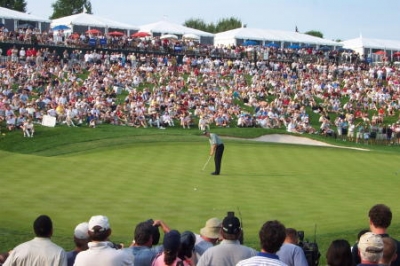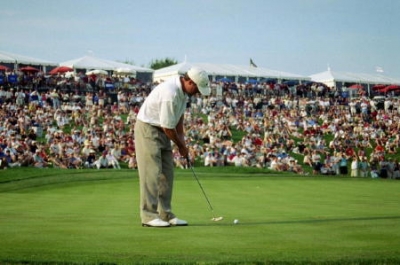By Rick Zarlengo, PGA
BRISTOW, VA -- Editor's Note: This is the third installment of a monthly golf instructional series written by Rick Zarlengo, General Manager of the Broad Run Golf & Practice facility in Bristow. This month's subject is putting basics. See Part I at Alignment Made Easier, or Part II at Connecting With Your Clubs.
Putting 101 (The Simple Approach)
When approaching putting, do so with the following idea: "once you have read the green, putting is only two things: distance and direction."
When sizing up a putt, your starting position should be about four steps behind the ball. This is how you determine the best view of the potential line. Once you determine your line, do everything in your power to properly aim the putter, then align your body and get comfortable. As you visualize the putt, think only distance.
 |
| Bob Estes was the picture of putting excellence at last year's Capital Open. |
Your brain (mine too!) doesn't do very well thinking of more than one thing at a time and, if the truth be known, would actually work best if it had no conscious thought at all. Brad Faxon -- who is one of the best putters on the PGA Tour, was asked what he thinks about when he's putting well, and he responded "nothing."
Don't clutter your mind with thoughts, clear your brain and make the best stroke possible.
"That's fine" you say, "but how do I develop a stroke that will allow me to not think of direction?"
The answer is developing TRUST through what I would call experimental practice -- the art of going out on the practice green and trying a number of different putters with a number of different hand positions (grips) and see what works best (most consistent) for you.
There are some very basic putting fundamentals to follow, but your personal, repeatable and, most importantly trustworthy stroke will come from this experimentation. WARNING: DO NOT CONTINUALLY CHANGE! Once you have found a steady routine, keep it for a minimum of six weeks.
The putting stroke is a motion of the arms and shoulders swinging the middle of the shaft toward the target. Contact with the ball is incidental. Therefore, the stroke can and should be practiced both with and without the ball. Also, it should be done to a target and to no target whatsoever.
 |
| Bob Burns had also reached a putting comfort level that allowed him to have his best finish on the PGA Tour to date (he won later on in the year). |
Remember, we are looking for a stroke that will provide the same direction each time. Your practice -- which will establish true roll (not even the slightest sidespin) -- will lead to improved touch (the ability to roll a ball the needed/a specific distance).
Take some time, go build your putting game and then enjoy the rewards!
Details:
Note: Broad Run Golf & Practice Facility is located off of Rt. 28 going south out of
For a complete look at Broad Run, try the GolfTheMidAtlantic.com review of the facility.
Broad Run Golf & Practice Facility
Phone: (703) 365-2443
FAX: (703) 365-2544
Website: www.broadrungolf.com
| Related Links | Comments on this article? | |
|
Maryland National Golf Club Hollow Creek Golf Club Rocky Gap Resort PB Dye Golf Club in Ijamsville Whiskey Creek Golf Club |
E-mail Jeff Rendall, Editor: jrendall@golftheunitedstates.com |












